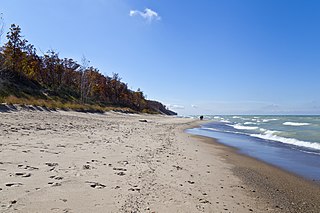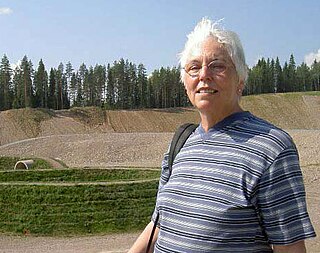
Land art, variously known as Earth art, environmental art, and Earthworks, is an art movement that emerged in the 1960s and 1970s, largely associated with Great Britain and the United States but that also includes examples from many countries. As a trend, "land art" expanded boundaries of art by the materials used and the siting of the works. The materials used were often the materials of the Earth, including the soil, rocks, vegetation, and water found on-site, and the sites of the works were often distant from population centers. Though sometimes fairly inaccessible, photo documentation was commonly brought back to the urban art gallery.

Indiana Dunes National Park is a United States national park located in northwestern Indiana managed by the National Park Service. It was authorized by Congress in 1966 as the Indiana Dunes National Lakeshore and was redesignated as the nation's 61st national park on February 15, 2019. The park runs for about 20 miles (32 km) along the southern shore of Lake Michigan and covers 15,349 acres (6,212 ha). Along the lakefront, the eastern area is roughly the lake shore south to U.S. 12 or U.S. 20 between Michigan City, Indiana, on the east and the Cleveland-Cliffs steel plant on the west. To the west of the steel plant lies West Beach and a small extension south of the steel mill continues west along Salt Creek to Indiana 249. The western area is roughly the shoreline south to U.S. 12 between the Burns Ditch west to Broadway in downtown Gary, Indiana. The area conservation scheme is enhanced by the older Indiana Dunes State Park. In addition, there are several outlying areas, including Pinhook Bog, in LaPorte County to the east; the Heron Rookery in Porter County, the center of the park; and the Calumet Prairie State Nature Preserve and the Hobart Prairie Grove, both in Lake County, the western end of the park.
Environmental archaeology is a sub-field of archaeology which emerged in 1970s and is the science of reconstructing the relationships between past societies and the environments they lived in. The field represents an archaeological-palaeoecological approach to studying the palaeoenvironment through the methods of human palaeoecology. Reconstructing past environments and past peoples' relationships and interactions with the landscapes they inhabited provides archaeologists with insights into the origin and evolution of anthropogenic environments, and prehistoric adaptations and economic practices.

The Nevada Museum of Art, is an art museum in Reno, Nevada.

Minute Man National Historical Park commemorates the opening battle in the American Revolutionary War. It also includes the Wayside, home in turn to three noted American authors. The National Historical Park is under the jurisdiction of the National Park Service and protects 970 acres (392.5 ha) in and around the Massachusetts towns of Lexington, Lincoln, and Concord.

Historic New England, previously known as the Society for the Preservation of New England Antiquities (SPNEA), is a charitable, non-profit, historic preservation organization headquartered in Boston, Massachusetts. It is focused on New England and is the oldest and largest regional preservation organization in the United States. Historic New England owns and operates historic site museums and study properties throughout all of the New England states except Vermont, and serves more than 198,000 visitors and program participants each year. Approximately 48,000 visitors participate in school and youth programs focused on New England heritage.

Environmental art is a range of artistic practices encompassing both historical approaches to nature in art and more recent ecological and politically motivated types of works. Environmental art has evolved away from formal concerns, for example monumental earthworks using earth as a sculptural material, towards a deeper relationship to systems, processes and phenomena in relationship to social concerns. Integrated social and ecological approaches developed as an ethical, restorative stance emerged in the 1990s. Over the past ten years environmental art has become a focal point of exhibitions around the world as the social and cultural aspects of climate change come to the forefront.

Wendover Air Force Base is a former United States Air Force base in Utah now known as Wendover Airport. During World War II, it was a training base for B-17 and B-24 bomber crews. It was the training site of the 509th Composite Group, the B-29 unit that carried out the atomic bombings of Hiroshima and Nagasaki.
Land Arts of the American West is a studio-based field program that seeks to construct an expanded definition of land art through direct experience connecting the full range of human interventions in the landscape—from pre-contact indigenous to contemporary practice. Land art includes everything from constructing a road, to taking a walk, building a monument, and leaving a mark in the sand. The program seeks to expand upon connections between typically separate fields. Each fall we spend two months camping while traveling 7,000 miles to engage sites that range from the CLUI complex at Wendover, Utah to the pottery culture at Mata Ortiz, Mexico, from earth works like Robert Smithson's Spiral Jetty to archeological sites like Chaco Canyon. We learn from the fact that Donald Judd surrounded himself with both contemporary sculpture and Navajo rugs; that Chaco Canyon and Roden Crater function as celestial instruments; and that the Very Large Array is a scientific research center with a powerful aesthetic presence on the land. We spend the semester living and working in the landscape with guest scholars that expand the range of our definition in disciplines including archeology, art history, architecture, ceramics, criticism, writing, design, and studio art. The immersive nature of how we experience the landscape triggers an amalgamated body of inquiry where students have the opportunity of time and space to develop authority in their work through direct action and reflection. Land Arts hinges on the primacy of first person experience and the realization that human-land relationships are rarely singular.
Joy Garnett is an artist and writer from New York, United States. Trained as a painter, her work explores contemporary practices around cultural preservation, alternative histories and archives. Her interdisciplinary work combines creative writing, research and visual media. In her early paintings (1997-2009), Garnett engaged issues around contemporary consumption of media and the distinctions between documentary, technical, and artistic image making. Her mature work draws on archival images, alternative histories and the legacy of her maternal grandfather, the Egyptian Romantic poet, bee scientist and polymath Ahmed Zaki Abu Shadi. Garnett is married to conceptual photographer and video artist Bill Jones.

Atomic tourism or nuclear tourism is a recent form of tourism in which visitors learn about the Atomic Age by traveling to significant sites in atomic history such as nuclear test reactors, museums with nuclear weapon artifacts, delivery vehicles, sites where atomic weapons were detonated, and nuclear power plants.

Nancy Holt was an American artist most known for her public sculpture, installation art, concrete poetry, and land art. Throughout her career, Holt also produced works in other media, including film and photography. Since 2018, her legacy has been cared for by Holt/Smithson Foundation.
Lucy Rowland Lippard is an American writer, art critic, activist, and curator. Lippard was among the first writers to argue for the "dematerialization" at work in conceptual art and was an early champion of feminist art. She is the author of 21 books on contemporary art and has received numerous awards and accolades from literary critics and art associations.
The San Diego Correctional Facility, also known as the Otay Mesa Detention Facility, is a minimum / medium security federal prison for men, managed by Corrections Corporation of America under contract with the United States Marshals Service and U.S. Immigration and Customs Enforcement (ICE).
The Chickasaw meridian begins on the north boundary of Mississippi in latitude 34° 59' north, longitude 89° 15' west from Greenwich, extends south to latitude 33° 48' 45" north, and governs the surveys in north Mississippi.

Patricia Johanson is an American artist. Johanson is known for her large-scale art projects that create aesthetic and practical habitats for humans and wildlife. She designs her functional art projects, created with and in the natural landscape, to solve infrastructure and environmental problems, but also to reconnect city-dwellers with nature and with the history of a place. These project designs date from 1969, making her a pioneer in the field of ecological-art Johanson's work has also been classified as Land Art, Environmental Art, Site-specific Art and Garden Art. Her early paintings and sculptures are part of Minimalism.
Ecological art is an art genre and artistic practice that seeks to preserve, remediate and/or vitalize the life forms, resources and ecology of Earth. Ecological art practitioners do this by applying the principles of ecosystems to living species and their habitats throughout the lithosphere, atmosphere, biosphere, and hydrosphere, including wilderness, rural, suburban and urban locations. Ecological art is a distinct genre from Environmental art in that it involves functional ecological systems-restoration, as well as socially engaged, activist, community-based interventions. Ecological art also addresses politics, culture, economics, ethics and aesthetics as they impact the conditions of ecosystems. Ecological art practitioners include artists, scientists, philosophers and activists who often collaborate on restoration, remediation and public awareness projects.
The Pew Center for Arts & Heritage is a nonprofit grantmaking organization and knowledge-sharing hub for arts and culture in Philadelphia, Pennsylvania, US established in 2005. In 2008, Paula Marincola was named the first executive director. The Center receives funding from The Pew Charitable Trusts and makes project grants in two areas, Performance and Exhibitions & Public Interpretation, as well as awarding grants to individual artists through Pew Fellowships. In 2021, the Center announced the introduction of Re:imagining Recovery grants to assist in COVID-19 recovery.

Mary Miss is an American artist and designer. Her work has crossed boundaries between architecture, landscape architecture, engineering and urban design. Her installations are collaborative in nature: she has worked with scientists, historians, designers, and public administrators. She is primarily interested in how to engage the public in decoding their surrounding environment.
M12, aka M12 STUDIO, is an American artist collective and non-profit organization based in Colorado that features an evolving group of artist practitioners, curators, and designers. Together they create artworks, research projects, and education programs that explore rural cultures and landscapes. Initially formed as the municipalWORKSHOP in 2002 in York, Alabama by Richard Saxton when he was an artist-in-residence at the Rural Studio, an architecture studio run by Auburn University, the group evolved into M12 in 2007 when it became incorporated as a non-profit organization. The core members have created over 20 projects since founding; their work was featured in the 2014 publication "A Decade of Country Hits: Art on the Rural Frontier."













